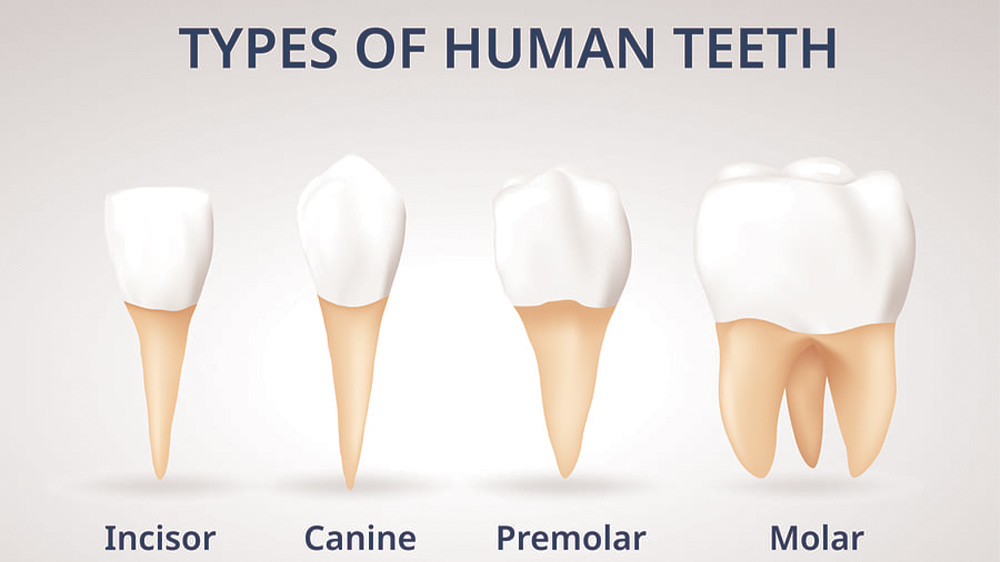According to statistics, the shape and number of human teeth have been transformed throughout centuries. Our jaws, teeth and quantity of teeth have adapted to our lifestyles as we change. Here we analyze the human teeth.
Number of Each Type of Modern Human’s Teeth
During your lifetime, a total number of 52 teeth grow in your mouth. The buds of these teeth are formed during the fetal period. There are exactly 20 milk teeth or temporary teeth and 32 permanent teeth. Different types of teeth are introduced separately as follows:
Number of Milk Teeth
There are 20 milk teeth, 10 of which grow in each jaw. There are four incisors, two canines, and four molars in each jaw. They start growing from the age of six months until three years of age. The incisors grow between 18 months till 6 years of age. They fall between the ages of six and eight years. The canines grow between the ages of 16 and 22 months but fall between the ages of 10 and 12 years. Finally, the molars grow between the ages of 19 and 33 months but fall between the ages 10 and 12 years.

Number of Permanent Teeth
There are 32 permanent teeth, 16 of which grow in each jaw. In fact, there are four incisors, two canines, four pre-molars, and six molars in each jaw. The last molars in the human mouth are classified as are called the wisdom teeth.
Different teeth have different roles. Here we talk about each tooth separately.
Number of Incisors (Anterior Teeth)
The incisors (i.e., anterior teeth) are located in the frontal space of your mouth. There are four incisors in the maxilla and four others in the mandible. These teeth are wide and have large abrasion surfaces, thus they are highly in contact with foods. Their main function is to take and tear food apart.

Because of adaptations, early humans had four incisors, which has completely differed from those of the modern human’s in shape. Their teeth used to be taller and sharper to meet the nutritional requirements of early humans. Over the years, the quantity of these teeth has reduced in some humans. In fact, some people now lack lateral incisors, something which deprives them of a beautiful smile.
Number of Canines
Everyone has four canines, which are sharper than the other teeth. Their pointy structure reduces their contact surface with the food but increases pressure on each bite. In fact, canines are used to tear comestibles apart and create holes into bites. Early humans had four canines, however, theirs were much taller and sharper, resembling what we see in predators today. Next to each canine, there is a space between. This is because this allows the jaw to close properly, and the opposite canine can fit there.

Number of Premolars
There are four premolars in each jaw, where two of them are located near each canine. These teeth have wide contact areas and sharp bumps used to chew, crush, and pulverize comestibles. Early humans had four premolars in each jaw. Their premolars were much larger and sharper. At the current rate, the quantity of these types of teeth is reducing today.
In some modern humans, the buds of the fifth premolars grow smaller than normal or may even stop growing. Thus they have become fewer due to the lack of sufficient space in their jaws. If there are too many teeth in a small jaw, the teeth start to grow irregularly and become congested. In this case, patients should see an orthodontist and start an orthodontic treatment.

Number of Molars
Located at the end of each side in a jaw, there are six molars. These teeth are called the first, second, and third molars. The third molar is known as the wisdom tooth. Having the largest areas of contact with comestibles, molars are used for crushing, chewing, and pulverizing food excessively.
The wisdom teeth have no role in chewing food now, although they were used to crush and chew comestibles by early humans. These teeth are extracted with surgery in most people. Early humans had six very large molars in each jaw. Those molars were as sharp as saws. In modern humans, two of these teeth are disappearing and deteriorating in each jaw. These teeth are now known as wisdom teeth.
Our predictions are that wisdom teeth will disappear (four molars in each jaw). Many humans aren’t born with molars naturally.
Maxillofacial and Dental Transformations through Time
Our early stages, we had long jaws resulting in face indexing and depriving them of a chin expression. Back to current times, jaws have grown smaller and given people a chin expression, which is considered an aesthetic factor.

Nearly seven million years ago, our primitive ancestors had very tall but small chins, this results in face indexing. Their canines were tall and sharp. Moreover, their teeth were located on two parallel rows. The jaws and teeth of our ancestors resemble those of modern chimpanzees. They had rectangular or U-shaped teeth in their jaws, a diastema near each canine. These gaps were the spaces for large canines to fit in when the jaws were closed. There was a diastema in front of a canine in the maxilla, but there was one behind a canine in the mandible.
Canines started to shrink nearly 5.5 million years ago. According to the research findings, the teeth started to line up from back to forth two million years after they started to shrink.
Nearly 1.8 million years ago, the canines of our ancestors were short and nearly flat, similar to us currently. As a result, their faces became more vertical and made their lateral rows of teeth take the form of an arch.

Comparing Early Human’s Teeth with Modern Human’s Teeth
Early humans had relatively large incisors (i.e., four anterior teeth in the maxilla and the mandible). Their maxillary incisors were so large and visible. Canines were much longer, sharper, and larger in early human men than in early human women. They had large molars with bumps on the surface. Their teeth were covered with a thin layer of enamel.
The emergence of distinct facial and dental features. The teeth were shaped into an arch or parabola inside the jaws. There are now no gaps between canines and other teeth.
Incisors have become relatively small. They are now thin and vertical. Canines are now shorter (and nearly at the same height as the other teeth). They are relatively flat. Male canines are similar to female canines in size. Molars have become smaller. They are now relatively flat with round but prudent edges. The teeth are covered with a thick layer of enamel.
Number of Human Teeth FAQ
Naturally, a human being has 32 teeth including incisors, canines, molars, and wisdom teeth.
Everyone has eight incisors, four canines, eight premolars, and eight molars.
An adolescent (aged 12–18 years old) grows teeth completely and should have 28 teeth.
No. The number of teeth has nothing to do with the human jaw size. Everyone has the same number of teeth, but people with smaller jaws are likely to grow their teeth irregularly due to insufficient space in the mouth.
Yes. Researchers and dentists believe that the number and shape of teeth are still changing. They may experience substantial transformations in the next centuries. An anticipated change is reduction in the number of human teeth.
This information was collected from the remaining fossils and skeletons, which contribute greatly to new discoveries.
The most serious complications now are dental plaques and cavities that will lead to decay.
The modern human’s teeth function as aesthetic features, but early humans used their teeth only to eat the hunter foods. This is another distinction between the modern human’s teeth and early humans.
According to the research findings, the early humans did not experience such problems.
The tracks on the early human’s teeth indicate the experience of stress in life. These tracks represent another difference between their teeth and the modern human’s teeth.







